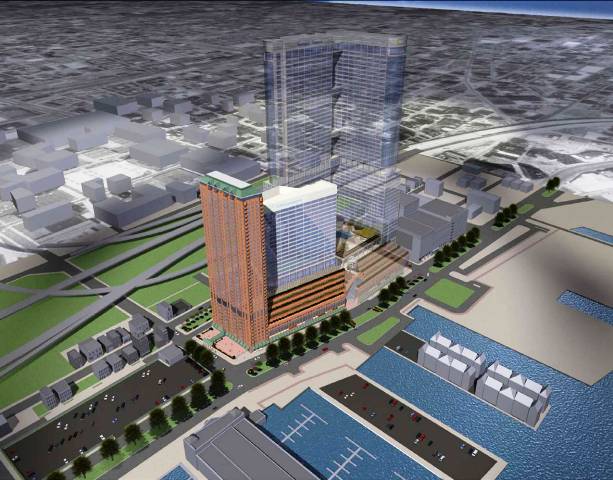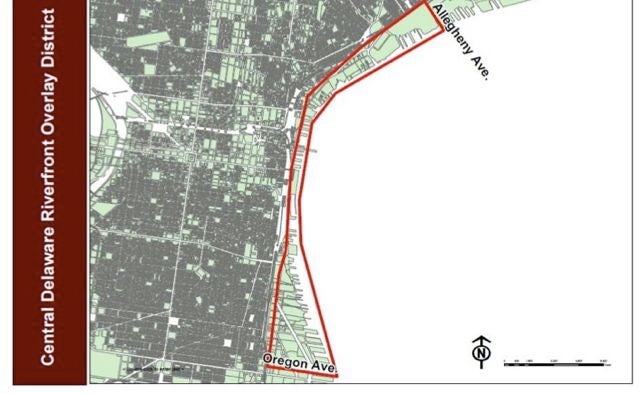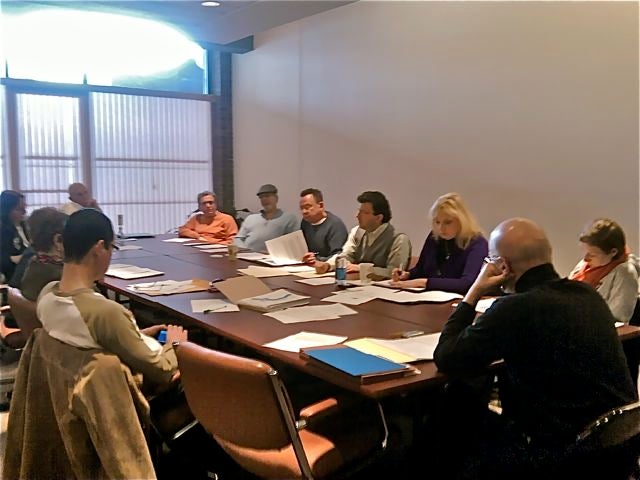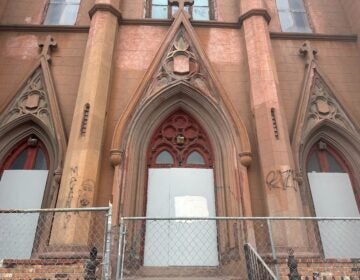Amendment on height would benefit WTC
Feb. 14, 2010
By Kellie Patrick Gates
For PlanPhilly
The Philadelphia Planning Commission will Tuesday consider an amendment to the Central Delaware Overlay that would eliminate height restrictions on waterfront parcels between Allegheny and Oregon Avenues.
Most of the parcels have no height limits now, but the change would eliminate a 65-foot height restriction that the developers of the long-in-the-works Philadelphia World Trade Center called a major impediment to their project.
The amendment, authored by First District Councilman Frank DiCicco and scheduled to be introduced at the Feb. 23 committee on the rules city council hearing, was also discussed at Sunday’s Central Delaware Advocacy Group meeting. It states: “Except for parcels of land zoned residential or C-2 commercial, no height regulations shall apply to any parcel within the boundaries of this District, including but not limited to the provisions of §14-1610 (“Old City Residential Area Special District Controls”).”
The Old City Special District limits building height to 65 feet.
CDAG voted Sunday not to support the amendment unless and until the planning commission can provide a list of all parcels that will lose height restrictions.
https://www.youtube.com/watch?v=oolCeAjHQSY
Planning Commission Deputy Executive Director Gary Jastrzab referred detailed questions about the zoning change to William Kramer, the commission’s division director of development and planning, who Jastrzab said has more knowledge about such specifics. Kramer could not be reached for comment Friday.
But, said Jastrzab of the proposal, “part of this has to do with the World Trade Center development.”
On Friday, his last day as DiCicco’s policy chief, Brian Abernathy said that he couldn’t comment about the World Trade Center project, planned for Delaware Avenue at Callowhill Street. “What I can say is that this legislation is not because of them or for them.”
On Sunday, CDAG Chairman Steve Weixler told his board, “It is my understanding, having a telephone conversation with Brian Abernathy, that this action, this amendment was the remedy of the legal action.”
After the meeting, Weixler said that Abernathy had never mentioned the World Trade Center by name in the phone conversation. “He said they had to correct the Old City overlay problem,” Weixler said.
https://www.youtube.com/watch?v=IBeL8KWgr8U
Reached by email Sunday, Abernathy said: “The legislation may impact the World Trade Center project but is neither a direct result or cause of WRA’s (Waterfront Renaissance Associates) lawsuit.”
Abernathy, DiCicco, Mayor Michael Nutter and other city officials, along with some waterfront neighborhood associations, were named in a 2007 lawsuit filed by Waterfront Renaissance Associates, the partnership that wants to build the Philadelphia World Trade Center. In October of 2009, The Philadelphia Inquirer reported that the city and the developer were in settlement negotiations, the crux of which were that the World Trade Center would be exempt from the 65-foot height restriction. A city attorney would not offer any detail on the settlement. (http://www.philly.com/philly/news/20091027_Proposed_settlement_offered_with_local_trade_towers.html)
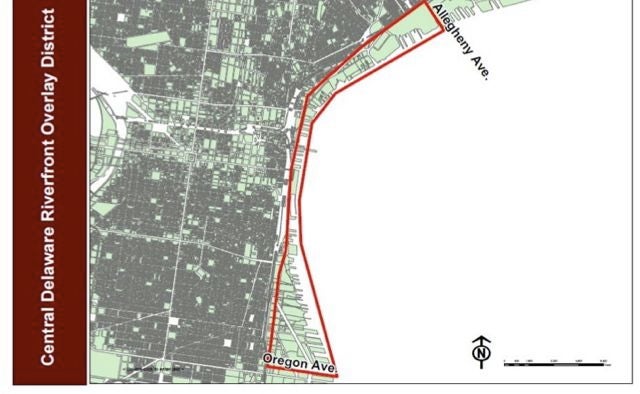
Andrea Townrow, manager of business development for the World Trade Center of Philadelphia, was unaware of the proposal, but said she would be paying attention to it now. While her organization would be housed at the building, another firm, Carl Marks & Co. of New York, holds the development rights, she said. She referred calls to Marks Managing Director Martin Schiffman, who she said would be more aware of anything related to construction. He could not be reached for comment Friday.
In a June, 2008 letter to PlanPhilly, Vince Powers , acting as a spokesman for Waterfront Renaissance Associates, owner of the proposed World Trade Center site at Callowhill Street – said the 65-foot height limit was a huge obstacle.
https://www.youtube.com/watch?v=_sZOP9KfayE
“The height restriction has had the effect of destroying this $300 million, three building “first phase” of the project, because WRA is confronted with two conditions which are currently irreconcilable: 1) the first building is incorrectly designed if the adjoining office tower and parking garage cannot be built, and 2) the first building cannot be redesigned without losing its permit and subjecting it to the 65’ height limit,” he said. (http://planphilly.com/node/3345)
Powers was out of the office on business Friday.
The amendment would actually not change height requirements for most of the parcels within the Central Delaware Overlay.
The relatively few parcels zoned as residential or C-2 commercial – a designation that the planning commission’s Jastrzab described as that of corner stores and other small-scale “mom and pop” businesses, would keep their current height restrictions.
Under city zoning code, parcels with higher-density commercial classifications – C-3, C-4, C-5 – have no height restrictions. It is only with zoning overlays that height restrictions have been superimposed. The amendment would override any other overlay that crosses into the Central Delaware Overlay, Abernathy said. But the only one he knows of is the Old City Special District overlay.
https://www.youtube.com/watch?v=u9Z_2iJQIWw
And Joe Schiavo, a representative of both the Old City Civic Association and CDAG, said Friday that a large portion of the Old City Special District does not stretch to the waterfront. The original portion, which went only from behind the buildings on the north side of Market Street to Wood Street, extends only to I-95, he said. The Old City Special District did not have any height controls at first, but they had been added by the time the District’s northern boundary was extended to Wood Street in 2006, he said.
Schiavo said that Old City Civic has no issue with tall buildings and “appropriately dense” development anywhere north of the Ben Franklin Bridge. Old City supports the World Trade Center project, he said.
The city’s higher-density commercial designations – C-3, C-4 and C-5 – do have height-to-width ratio requirements, which essentially say the taller a building, the smaller the percentage of its lot it may occupy. Those requirements are not touched by the amendment, Abernathy said.
https://www.youtube.com/watch?v=kvVlpEUO_K8
This is important, Schiavo said, because this is what helps to keep density at an appropriate scale. Old City’s only concern about the amendment, in fact, is a technical one, Schiavo said.
Where the bill says that height restrictions would not apply within the District, Old City wants the councilman to add the words “Central Delaware.” The Association wants to make sure that no one in the future can try to claim the height restriction has been stripped from all of the Old City special district.
Abernathy said the Central Delaware Overlay’s intent was always to foster dense development on the land it covers, between Allegheny and Oregon Avenues, I-95 and the river.
https://www.youtube.com/watch?v=ZXeE7fAH5Og
The exclusions for residential and light commerical zones came in response to community concerns, he said. “We understand there are some low-density areas – on South Delaware Avenue, there is a significant area of low density,” he said. “At the same time, everyone recognizes that density north of the Ben Franklin Bridge is a positive thing.”
DiCicco doesn’t want to touch the C-2 and residential zone height restrictions, at least until the Central Delaware Waterfront Master Plan, which is now being worked on, is complete, Abernathy said. “That’s what the planning process is for,” he said.
Speaking of the planning process, the Central Delaware Waterfront Overlay requires that any project proposed for the river side of Delaware Avenue/Columbus Boulevard undergo a review by the planning commission.
https://www.youtube.com/watch?v=keOrueiJCxs
Paul Boni, a Society Hill resident who is also the attorney for an anti-casino organization, questioned why DiCicco wasn’t holding off on any zoning changes, instead letting them happen through the master plan process.
Boni said it may be a good thing for the city to make some sort of accomodation that would allow the Philadelphia World Trade Center to be built, but he doesn’t think eliminating any overlay height restriction is the answer. It’s too broad, he said. “This is killing a mosquito with an elephant gun,” he said.
Boni brought up similar concerns at Sunday’s CDAG meeting, where he made a presentation about the proposed planning commission guidelines for implementing the overlay (more on that topic later.)
https://www.youtube.com/watch?v=04ZpzHYKBVc
Boni also suggested that CDAG request DiCicco make a change to the amendment, specifically stating it would not override the height restrictions in the Central Delaware’s two Commercial Entertainment Districts. CEDs are the zoning classification that allow casinos.

CDAg member Jeff Rush said that regardless of whether the amendment passes, neither casino could change its approved plan of development without the blessing of both the city planning commission and the Pennsylvania Gaming Control Board.
Fellow CDAG member Jim Moss read language from the CED ordinance that states it overrides any other legislation that conflicts with it. That means neither the Central Delaware Overlay nor any amendment to it would apply to a CED.
Most board members seemed appeased by this. But Boni urged them to ask the councilman to insert language into his amendment specifically stating the CED height restrictions would stand, in part to avoid a potential resolution in the courts.
CDAG member Patrick Starr, who is president of the Pennsylvania Environmental Council, was exasperated. He wanted to know precisely which parcels would lose height restrictions under the proposal, and who would benefit. “It’s so back door,” he said. Someone at the planning commission should be able to produce this information, Starr said.
The board unanimously adopted his motion that CDAG tell the planning commission it cannot support the proposed amendment without this information.
https://www.youtube.com/watch?v=Q13J1PcHsBA
CDAG members were also concerned by a set of parenthesis in the amendment. At the top of the first version of the amendment, it states that items in parenthesis are deletions. The new version says strike throughs are deletions, but at the bottom, it also says parenthesis means deletion.
With that in mind, it seemed to some CDAG members that DiCicco was eliminating language that requires property owners to maintain the public waterfront setback required by the overlay, unless they transfer control of that property to the city. The language and parenthesis in question appear here:
The City or its agent shall have care, custody and control of the waterfront setback and recreational trail. Dedication may be made in a deed of dedication, deed of easement or other similar transfer acceptable to the City. [If the property owner does not dedicate the waterfront setback to the City or its agent, the property owner shall be responsible for maintaining the waterfront setback open to the public, constructing a recreational trail and maintaining the recreational trail.]
https://www.youtube.com/watch?v=hmPUswzKPT4
Weixler said that he thought the parenthesis were either an error or their meaning was being misinterpreted, because none of his discussions with the councilman’s office included information about a change to setback requirements. The board agreed to tell the planning commission that if indeed the parenthesis mean that sentence is removed from the bill, CDAG does not support it.
Weixler said that CDAG will also be attending the rules committee hearing to make its positions known to council. DiCicco’s amendment addresses another issue: He will also ask that council give the planning commission two more months to approve the regulations that provide specific guidelines on how the overlay is applied to proposed developments.
https://www.youtube.com/watch?v=HP5oQwnFR4w
The commission was set to approve a set of regulations at its January meeting, but it was asked to hold off by representatives from neighborhood groups and a development group, which said the public should have more time to comment on the proposal. That meant the PCPC would not meet the six-month deadline included in the overlay legislation. If council approves the amendment, the commission would have a new April deadline, which would give it more time to hear or read comments from the community and interested organizations, Jaztrzab said.
Jastrzab said the commission has received several dozen comments from residents of Northern Liberties, all via the same email form.
Northern Liberties Neighbors Association President Matt Ruben has distributed an email with links to a comment form and the current, unapproved plan of development regulations. The letter says great things are happening on the waterfront, including the overlay. But, Ruben says, the planning commission’s “draft guidelines cut the public and communities almost entirely out of the process.”
The commission will make a recommendation on the overall bill Tuesday, Jastrzab said, but it will not be addressing the regulations.
The commission has not yet received comment from the Development Workshop, the pro-development non-profit that originally asked the commission to delay its vote on the guidelines in January – or CDAG, Jastrzab said.
https://www.youtube.com/watch?v=e57NFUGfkxU
CDAG began working on its suggestions for the regulations in earnest Sunday, and Weixler said he wanted a committee to focus exclusively on this issue, which he called one of the most important CDAG has ever dealt with. While the Central Delaware Overlay will only exist until it is replaced with a master plan and permanent zoning, Weixler said the guidelines will impact their replacements. He also warned members to anticipate a special board meeting to discuss only the topic.
At the request of the board, Boni presented a first draft list of recommendations that represent a joint effort between Society Hill Civic, CDAG and Penn Praxis’ Michael Greenle, who provided technical assistance. (PennPraxis oversaw the public process that resulted in the Vision for the Central Delaware Waterfront, which guided both the zoning overlay and the master plan that is now in progress).
Boni praised the planning commission for the work done on the draft guidelines, and said they were good, but could be better. Recommendations from the review, contained in a draft document that CDAG will work on before presenting an official position paper to the Commission, include:
– The plan of development should be available online 30 days prior to when the commission meets to review it, and the commission should give 30 days’ notice on the hearing on its website.
– Commission staffers’ review of the POD should be available online three days prior to the meeting.
– The commission should be able to adminsiter oaths and take testimony, and issues subpoenas.
– The commission should develop design standards to guide their discretion when they decide whether a project is “appropriate in terms of scale, density, character and use for the surrounding community.”
– The overlay requires a waterfront setback of 100 feet, but relief can be granted if that is unfeasible. The draft document says the commission create standards to help it determine if the called-for setback really is unfeasible, and that applicants would have to demonstrate feasibility or lack thereof to the Commission.
Tentative recommendations also include requiring the applicant to provide details about what conditions already exist on the site, and to provide preliminary (“a non-invasive, desktop review”) investigations regarding archaeology and environmental conditions.
Contact the reporter at kelliespatrick@gmail. com
WHYY is your source for fact-based, in-depth journalism and information. As a nonprofit organization, we rely on financial support from readers like you. Please give today.



